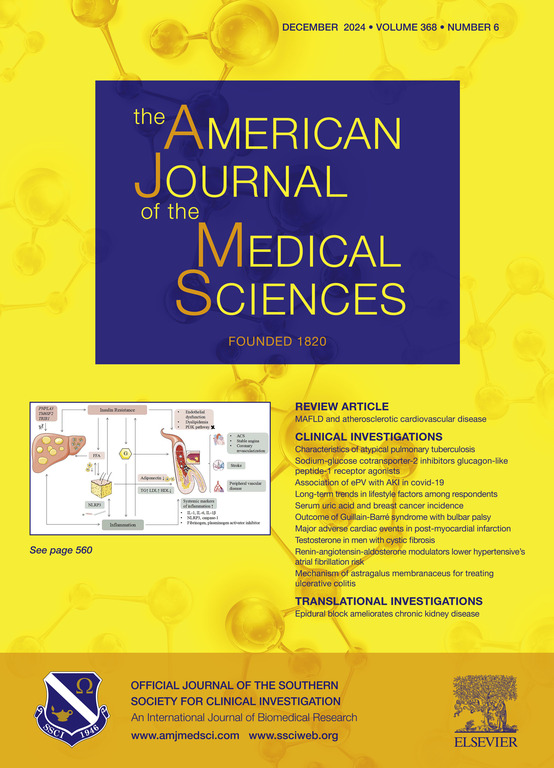GLP-1 受体激动剂和 SGLT-2 抑制剂联合或单药治疗 2 型糖尿病的有效性和安全性:最新系统综述与 Meta 分析》。
IF 1.8
4区 医学
Q2 MEDICINE, GENERAL & INTERNAL
引用次数: 0
摘要
目的:评估钠-葡萄糖共转运体2(SGLT-2)抑制剂和胰高血糖素样肽-1(GLP-1)受体激动剂联合治疗2型糖尿病(T2DM)的疗效和安全性:为了建立一个有关 SGLT-2 抑制剂和 GLP-1 受体激动剂的随机对照试验 (RCT) 的详尽数据库,我们在一系列数据库(如 Embase、PubMed 和 Cochrane Central Register of Controlled Trials)中进行了有条不紊的检索,检索时间从开始到 2023 年 1 月。然后,对收集到的数据进行荟萃分析,从而计算出一系列结果的标准化平均差 (SMD)、几率比 (OR) 和 95% 置信区间 (CI)。这种分析方法旨在对 SGLT-2 抑制剂和 GLP-1 激动剂治疗糖尿病的疗效和安全性进行定量评估:结果:与单独使用 GLP-1 激动剂治疗相比,联合疗法并未显著降低空腹血浆葡萄糖 (FPG) 水平(95% 置信区间 [CI]:-0.27,0.10;P=0.35)、体重(95% CI:-0.18,0.18;p=1.00)、糖化血红蛋白 A1C 型(HbA1c)(95% CI:-0.29,0.07;p=0.22)或收缩压(SBP)值(95% CI:-0.29,0.06;p=0.21)。相比之下,与单用 SGLT-2 抑制剂疗法相比,联合疗法可显著降低 FPG 0.24 mmol/L (95% CI: -0.43, -0.05; p=0.01)、HbA1c 0.45% (95% CI: -0.72, -0.18; p=0.001)和 SBP 0.12 mmHg (95% CI: -0.24, 0.00; p=0.05)。然而,与 SGLT-2 抑制剂疗法(95% CI:-0.20,0.05;p=0.24)或 GLP-1 激动剂疗法(95% CI:-0.18,0.18;p=1.00)相比,联合疗法未能显著降低体重。此外,联合疗法不会增加低血糖的发生率。值得注意的是,有关死亡率和心血管后果的数据有限:结论:与 SGLT-2 抑制剂单药治疗相比,SGLT-2 抑制剂和 GLP-1 受体激动剂联合治疗可有效降低 HbA1c、FPG 和 SBP,同时不会增加低血糖风险。然而,与单独使用 GLP-1 受体激动剂治疗相比,联合疗法并没有带来这些益处。本文章由计算机程序翻译,如有差异,请以英文原文为准。
Efficacy and safety of the combination or monotherapy with GLP-1 receptor agonists and SGLT-2 inhibitors in Type 2 diabetes mellitus: An update systematic review and meta-analysis
Purpose
To evaluate the efficacy and safety of combination therapy with sodium-glucose cotransporter2(SGLT-2) inhibitors and glucagon-like peptide-1(GLP-1) receptor agonists in the treatment of type 2 diabetes mellitus (T2DM).
Methods
To construct an exhaustive database of randomized controlled trials (RCTs) concerning SGLT-2 inhibitors and GLP-1 agonists, a methodical search was undertaken across a range of databases, such as Embase, PubMed, and the Cochrane Central Register of Controlled Trials, from their inception to January 2023. Following this, a meta-analysis was executed to amalgamate the collected data, which allowed for the calculation of standardized mean differences (SMDs), odds ratios (ORs), and 95 % confidence intervals (CIs) for a spectrum of outcomes. This analytical approach was designed to yield a quantitative evaluation of the therapeutic efficacy and safety profile of SGLT-2 inhibitors and GLP-1 agonists for the treatment of diabetes mellitus.
Results
When compared to GLP-1 agonist therapy alone, the combination therapy did not significantly reduce fasting plasma glucose (FPG) levels (95 % confidence interval [CI]: -0.27, 0.10; p = 0.35), body weight (95 % CI: -0.18, 0.18; p = 1.00), Glycosylated Hemoglobin, Type A1C (HbA1c) (95 % CI: -0.29, 0.07; p = 0.22), or systolic blood pressure (SBP) values (95 % CI: -0.29, 0.06; p = 0.21). In contrast, when compared to SGLT-2 inhibitor therapy alone, combination therapy significantly decreased FPG by 0.24 mmol/L (95 % CI: -0.43, -0.05; p = 0.01), HbA1c by 0.45 % (95 % CI: -0.72, -0.18; p = 0.001), and SBP by 0.12 mmHg (95 % CI: -0.24, 0.00; p = 0.05). However, the combination therapy failed to demonstrate a significant reduction in body weight when compared with either SGLT-2 inhibitor therapy (95 % CI: -0.20, 0.05; p = 0.24) or GLP-1 agonist therapy (95 % CI: -0.18, 0.18; p = 1.00). Additionally, the combination therapy did not increase the incidence of hypoglycemia. It should be noted that data regarding mortality and cardiovascular outcomes were limited.
Conclusions
The combination treatment of SGLT-2 inhibitors and GLP-1 receptor agonists effectively reduces HbA1c, FPG, and SBP without elevating the risk of hypoglycemia when compared to monotherapy with SGLT-2 inhibitors. However, these beneficial effects were not observed when the combination therapy was compared with GLP-1 receptor agonist treatment alone.
求助全文
通过发布文献求助,成功后即可免费获取论文全文。
去求助
来源期刊
CiteScore
4.40
自引率
0.00%
发文量
303
审稿时长
1.5 months
期刊介绍:
The American Journal of The Medical Sciences (AJMS), founded in 1820, is the 2nd oldest medical journal in the United States. The AJMS is the official journal of the Southern Society for Clinical Investigation (SSCI). The SSCI is dedicated to the advancement of medical research and the exchange of knowledge, information and ideas. Its members are committed to mentoring future generations of medical investigators and promoting careers in academic medicine. The AJMS publishes, on a monthly basis, peer-reviewed articles in the field of internal medicine and its subspecialties, which include:
Original clinical and basic science investigations
Review articles
Online Images in the Medical Sciences
Special Features Include:
Patient-Centered Focused Reviews
History of Medicine
The Science of Medical Education.

 求助内容:
求助内容: 应助结果提醒方式:
应助结果提醒方式:


